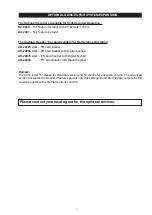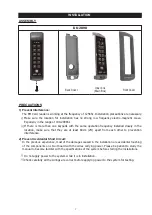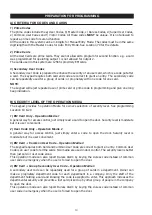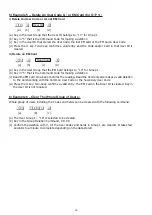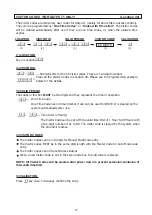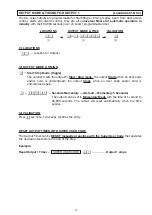
PREPARATION FOR PROGRAMMING
A) CRITERIA FOR CODES AND CARDS
1) Prime Codes
The prime codes include the a) User Codes, b) Master Code, c) Duress Codes, d) Super User Codes,
e) Common User Codes and f) Visitor Codes. All these codes
MUST
be unique. It is not allowed to
repeat a prime code for second function.
All the codes in this system can be 4-8 digits for Manual Entry Mode. The codes must be in the same
digit length with the Master Codes for Auto Entry Mode. See Location 70 for the details.
2) Prime Cards
All the User Cards are prime cards. They are not allowed to program for second function. e.g. a card
was programmed for operating output 1 is not allowed for output 2.
The cards used in this system are 125Khz proximity EM cards.
3) Secondary User Codes
A Secondary User Code is prepared to enhance the security of an user card, which is a code put after
a card. The keypad requires both card and code are correct to grant an entry. The secondary code
can be repeatedly used for a group of cards; or proprietary with one code for one card.
NOTE:
The keypad will reject repeated use of prime card or prime code in programming and give one long
beep indication.
B) SECURITY LEVEL OF THE OPERATION MEDIA
The keypad provides 5 operation Media for owner’s selection of security level. See programming
Location 10 & 20
1) EM Card Only – Operation Media 1
A general way for access control, just simply read a card to open the door. Security level is moderate
but it is user convenient.
2) User Code Only – Operation Media 2
A general way for access control, just simply enter a code to open the door. Security level is
moderate but it is user convenient.
3) EM Card + Common User Code – Operation Media 4
The keypad requires both Card and Common User Code are correct to grant an entry. Common User
Code is an user code for all the cards. Two media are used in door control. The security level is better
than just card or user code alone.
This operation mode can also report Duress Alarm by keying the duress code instead of common
user code in emergency when the user is forced to open the door.
4) EM Card + Group Secondary User Code – Operation Media 3
A secondary user code can be repeatedly used for a group of cards in a department. Owner can
make a proprietary department code for each department in a company. Only the staff of the
department holding a card and knowing the code is accepted to enter. This approach increases the
departmental security and prevents a lost card picked up by other group of people in the company
to open the door.
This operation mode can also report Duress Alarm by keying the duress code instead of common
user code in emergency when the user is forced to open the door.
APPLICATION EXAMPLES
STAND ALONE DOOR LOCK
NOTE:
DK-2890
ELECTRIC LOCK
Connect the 1N4004 as close as possible to the lock in parallel with the lock power terminals of the
lock to absorb the back EMF to prevent it from damaging the keypad. The 1N4004 is not required
if the electric lock is AC operated.
To avoid Electro-Static-Discharge from interfering with the operation of the keypad, always ground
the (-) terminal of the keypad to earth.
12V DC
POWER
SUPPLY
AD-1312
OR
AP-960
ELECTRIC LOCK
N.O. N.C.
OR
CATHODE
1N4004
OUTPUT RELAY
N.O. Output for
Fail-secure Lock
N.C. Output for
Fail-safe Lock
EGRESS
BUTTON
MORE EGRESS
BUTTONS CAN
BE CONNECTED
IN PARALLEL
N.O.
N.O.
THE WIRE HARNESS
BASIC WIRINGS OF A STAND ALONE DOOR LOCK
Summary of Contents for DK-2890
Page 2: ......
Page 48: ...AEI PROTECT ON SYSTEMS LIMITED www apo hk com...






